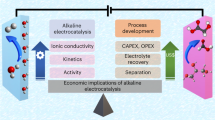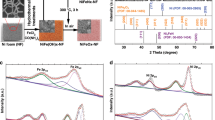Abstract
In this study, hydrothermal electrolysis experiments using glucose (a biorelated substance) as a starting material were carried out using a specially designed autoclave at 250°C. We could understand the fundamental reaction behavior of glucose under these conditions through various kinds of experiments and product analyses. Another series of experiments using pressurized CO2 as an electrolyte was conducted to discover whether it is possible to use CO2 as an alternative electrolyte to the conventional KCl electrolyte, with a view to lowering the environmental impact of the process. It was found that pressurized CO2 was useful as an environmentally friendly electrolyte, although there were still some problems in terms of the reaction efficiency.
Similar content being viewed by others
References
RM Serikawa M Isaka Q Su T Usui T Nishimura H Sato S Hamada (2000) ArticleTitleWet electrolytic oxidation of organic pollutants in waste water treatment J Appl Electrochem 30 875–883 Occurrence Handle10.1023/A:1004070303697 Occurrence Handle1:CAS:528:DC%2BD3cXlvFCgtrg%3D
H Nonaka K Katayama Y Matsumura (2003) ArticleTitleElectrochemical oxidation of glucose on a platinum electrode at 523 K (in Japanese) Kagaku Kougaku Ronbunsyu 29 188–190 Occurrence Handle1:CAS:528:DC%2BD3sXisFWjtr0%3D Occurrence Handle10.1252/kakoronbunshu.29.188
H Nonaka Y Matsumura (2002) ArticleTitleElectrochemical oxidation of carbon monoxide, methanol, formic acid, ethanol, and acetic acid on a platinum electrode under hot aqueous conditions J Electroanal Chemistry 520 101–110 Occurrence Handle10.1016/S0022-0728(01)00752-5 Occurrence Handle1:CAS:528:DC%2BD38Xhslynuro%3D
Goto M, Sasaki M (2006) Electrical Processes in Subcritical Water. In: Proceeding of the 4th International Symposium on Supercritical Fluid Technology for Energy, Environment and Electronics Applications, Taipei, Taiwan, November 2006
Sasaki M, Wahyudiono, Goto M (2006) Development of biomass upgrading technology with hydrothermal and supercritical water treatment. In: Proceeding of the 4th International Symposium on Supercritical Fulid Technology for Energy, Environment and Electronics Applications, Taipei, Taiwan, November 2006
Yamamoto K (2006) Electrolysis of organic compounds in subcriticcal water. Master's thesis at Kumamoto University, Kumamoto
Sasaki M (2005) Rapid and selective conversion of bio-related materials into chemical resources using supercritical water. In: Wakayama H (ed) Materials chemistry in supercritical fluids. Research Signpost, pp 23–29, Goto M (2006)
Author information
Authors and Affiliations
Corresponding author
Rights and permissions
About this article
Cite this article
Sasaki, M., Yamamoto, K. & Goto, M. Reaction mechanism and pathway for the hydrothermal electrolysis of organic compounds. J Mater Cycles Waste Manag 9, 40–46 (2007). https://doi.org/10.1007/s10163-006-0170-9
Received:
Accepted:
Published:
Issue Date:
DOI: https://doi.org/10.1007/s10163-006-0170-9




